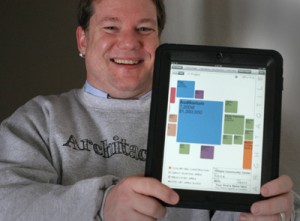Originally published in The Journal Record on January 21, 2011
By April Wilkerson
Used with permission

Matt Galloway, founder and chief technologist of the Tulsa company Architactile, shows the software application he created for the iPad. (Rip Stell)
TULSA – Matt Galloway knew he could find a creative solution. He just needed an industry with a specific problem.
Galloway made that discovery and used it to create the first product of his Tulsa-based startup company.
Galloway’s company is called Architactile, and he recently released Inception, a software application for the iPad that is geared toward a specific part of an architecture firm’s work. All sorts of technological tools exist for the design process of architecture, but nothing was available for the initial business development phase, he said. So he set his sights on that niche and created software that he says will simplify and speed up those initial steps with a potential client.
“My background is in technology, and my strength is being able to understand business domain,” he said. “I wanted to work with people who had a particular problem, then create new solutions to solve those problems. This is a tool to help architects accelerate the business development process.”
Inception landed in the Apple iTunes App Store last week and is priced at $499.99. Galloway began creating it by immersing himself in the architecture industry. One of his longtime friends is an architect who told him of the need, and Galloway said he was drawn to develop software business- to-business rather than for a consumer market.
Inception is a tool that an architectural firm can use when first sitting down with a client interested in a new building. Architect and client hash out building use, types of space and function needed as the first steps of the process, Galloway said. Those early conversations are high level, but a necessary prelude to the design process, he said.
“It lets them assess a preliminary budget for the entire project so the client can gauge whether they can move forward,” he said. “Inception provides the architect the tools to very quickly collect specifications for spaces, establish conceptual budget levels and to create a bubble diagram for the project.”
Currently, a business development person might take copious notes on a tablet, then use Excel to crunch numbers and Word to write up information. They also might hand-draw a bubble diagram or use something like AutoCAD or Visio. Depending on the size of the project, that process could take hours, days or weeks, Galloway said.
Inception is designed to allow that input directly on the iPad and create a PDF that can be e-mailed to the client.
“It can really cut down the time they spend, particularly outside the meetings, preparing documentation to get back to the client,” he said.
The fact that Inception was written for the iPad also makes a difference, Galloway said. If the architect were using the software on a laptop computer, the setting would be different.
“Those early meetings are a selling process, so they really need to maintain intimacy with the client,” he said. “If there were a laptop with the screen flipped up and you’re looking down at the screen, you lose that intimacy. But with the iPad, you’re using your finger and you can hand it back and forth. So for us, the iPad was an enabling technology. What we’re doing wouldn’t work if it was a piece of laptop software.”
Inception is starting to catch Oklahoma architects’ attention. Jim Hasenbeck, founding principal of Studio Architecture in Oklahoma City, has been getting to know the software and anticipates buying it for his firm. His architects discovered Inception on their own journey to using the iPad in their work. Hasenbeck said Studio Architecture bought an iPad for everyone in the office and challenged them to explore ways they could use it to better the firm. They met Galloway at an architect’s symposium last year.
“We got excited when we saw this because it’s very specific to our trade,” Hasenbeck said. “He has made that first stage of the process electronic. It’s a fact-gathering time to see if we can solve a problem.
“His app also allows you to input data and, in a short period of time, it is able to go out and grab other databases that are connected to it, like looking at code information,” he said. “(Previously) we had to go find the code and do it manually. This saves time and allows you more time to solve the problem.”
Hasenbeck said he anticipates Inception paying for itself in its first use on a project.
The price isn’t cheap, Galloway said, but because he’s creating software for an industry, he’s not going to sell a million apps.
Before starting Architactile, he worked for 13 years developing insurance compliance software. When that company was bought and employees let go, he used his severance as seed funding for his new company. His long-term goal is a suite of applications for the architecture industry, and he anticipates the iPad playing a bigger role as a business tool.
“I see the iPad as the first mobile device that can make a widespread impact in business,” Galloway said. “I think it will do that by people like me developing these types of point-solution, vertically oriented business applications.”

